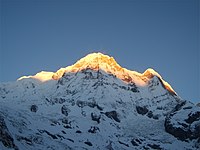The 2014 Nepal snowstorm disaster occurred in central Nepal on 14 October 2014 and resulted in the deaths of at least 43 people of various nationalities, including at least 21 trekkers. Injuries and fatalities resulted from unusually severe snowstorms and avalanches on and around the mountains of Annapurna and Dhaulagiri.[2] The incident was said to be Nepal's worst trekking disaster.
 Annapurna South seen from Annapurna Base Camp | |
| Native name | विसं २०७१ को हिमआँधी प्रकोप |
|---|---|
| Date | 14 October 2014 |
| Location | Manang and Mustang Districts, Nepal |
| Cause | Cyclone Hudhud |
| Deaths | 43 deaths[1] |
| Non-fatal injuries | 175 |
| Missing | 50 |
Events
editOn 14 October 2014, a snowstorm and series of avalanches occurred on and around Annapurna and Dhaulagiri in the Manang and Mustang Districts of Nepal within the Himalaya range.[2] According to an unnamed expert the storm arose from Cyclone Hudhud and was the worst in a decade with almost 1.8 metres (5 ft 11 in) of snow falling within 12 hours.[3] The storm resulted from the unusual merger of a tropical cyclone with an upper trough.[4][5]
Electric power, cell phone service, and internet connections failed in the Manang District, hampering relief efforts.[6] Trekkers in the area at the time of the storm consisted of citizens from several countries, including 78 from New Zealand.[7] One of the first calls for international assistance was raised by the Israeli embassy in Kathmandu after trapped tourists sent a hand-written note from the top of the pass with a local guide who descended the mountain.[8][9] Twenty-one trekkers and guides from Nepal, Slovakia, and Germany were rescued on 15 October after the avalanche the previous day.[9] When search and rescue operations ceased on 19 October, up to 400 people had been rescued from various areas including Thorong La,[2] the Manang and Mustang areas,[9] and the Tukuche basecamp of Mustang.[10]
The storms resulted in the deaths of at least 43 people.[1][11][12][13] Among the dead were 21 trekkers from several countries walking the Annapurna Circuit,[14] including two Slovak climbers at Dhaulagiri base camp,[9] and several local Nepali mountain guides, cooks, and yak herders.[15] Up to 50 people were estimated to be missing with 175 reported to have injuries such as severe frostbite.[15][16]
Legacy
editLocal authorities were criticised for not giving sufficient warning of approaching bad weather to the trekkers and local residents.[16] However, some officials believe that those killed or injured were inexperienced and inadequately equipped.[14][17] The Prime Minister of Nepal Sushil Koirala called the loss of life “extremely tragic at a time when worldwide weather updates are available every second”, and said that weather warning systems would be improved.[17] The Nepal Tourism Ministry said that the incident "has taught us a lesson”, and that more emergency shelters and better weather tracking and communication were needed to avert future tragedies.[14] Newly proposed procedures and regulations include a trekker registry, checkpoints, GPS tracking units and mandatory use of trained local guides.[17] However, regulations at the time required trekkers to check in at various waypoints and licensed guides were already recommended. There was no system in place at the time to inform trekkers of weather conditions en route.
See also
editReferences
edit- ^ a b "Death toll in Nepal's worst trekking disaster reaches 43". www.reuters.com. Reuters. Retrieved 22 October 2014.
- ^ a b c "Nepal Annapurna: Search ends for surviving trekkers". BBC News. 19 October 2014. Retrieved 19 October 2014.
- ^ "Nepal Annapurna: Trekking disaster toll reaches 39". BBC News. 18 October 2014. Retrieved 19 October 2014.
- ^ Wang, S.-Y., B. Fosu, R. R. Gillies, and P. M. Singh, 2015: The Deadly Himalayan Snowstorm of October 2014: Synoptic Conditions and Associated Trends. Bulletin of the American Meteorological Society, 96, S89-94.
- ^ Simon Wang, S.-Y.; Gillies, Robert R.; Fosu, Boniface; Singh, Pratibha M. (2015). "The Deadly Himalayan Snowstorm of October 2014: Synoptic Conditions and Associated Trends". Bulletin of the American Meteorological Society. 96 (12): S89–S94. doi:10.1175/BAMS-D-15-00113.1.
- ^ "What to do in Kathmandu?". transvaya. Retrieved 21 August 2015.
- ^ "Kiwis trek to safety after deadly Nepal avalanches". The New Zealand Herald.
- ^ "The note of desperation that helped save Nepal trekkers". 18 October 2014.
- ^ a b c d "Death toll passes 39 as freak snowstorms hit Annapurna region". British Mountaineering Council. 16 October 2014. Retrieved 19 October 2014.
- ^ "7 rescued from Tukuche base camp". Archived from the original on 26 December 2014. Retrieved 20 October 2014.
- ^ Sharma, Bhadra; Najar, Nida (15 October 2014). "Blizzard and Avalanche Kill at Least 20 Trekkers in Himalayas". The New York Times. Retrieved 19 October 2014.
- ^ Sharma, Gopal (15 October 2014). "Freak Nepal blizzards kill at least 20, including hikers, guides". Reuters. Retrieved 19 October 2014.
- ^ Kannampilly, Ammu (15 October 2014). "Himalayan blizzard, avalanche kill 17 trekkers in Nepal". Yahoo! News. Retrieved 19 October 2014.
- ^ a b c "Nepal tightens up mountain rules in wake of Himalayan hiking disaster". The Guardian. 21 October 2014. Retrieved 21 October 2014.
- ^ a b "Nepal trekking disaster: Britons still 'missing' after severe snow storm". The Telegraph. 19 October 2014.
- ^ a b "Nepal blizzard: survivor tells of friends' deaths on Annapurna circuit". The Guardian. 16 October 2014.
- ^ a b c "Nepal blames 'cheap tourists' for falling victim to snowstorm in Himalayas". The Guardian. 17 October 2014. Retrieved 19 October 2014.